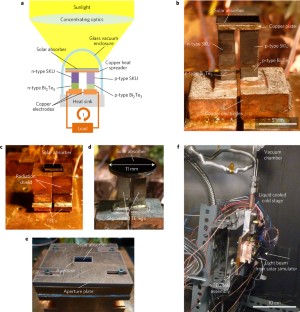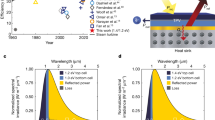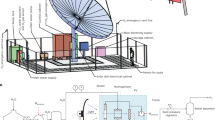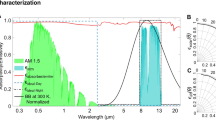Abstract
Concentrating solar power normally employs mechanical heat engines and is thus only used in large-scale power plants; however, it is compatible with inexpensive thermal storage, enabling electricity dispatchability. Concentrating solar thermoelectric generators (STEGs) have the advantage of replacing the mechanical power block with a solid-state heat engine based on the Seebeck effect, simplifying the system. The highest reported efficiency of STEGs so far is 5.2%. Here, we report experimental measurements of STEGs with a peak efficiency of 9.6% at an optically concentrated normal solar irradiance of 211 kW m−2, and a system efficiency of 7.4% after considering optical concentration losses. The performance improvement is achieved by the use of segmented thermoelectric legs, a high-temperature spectrally selective solar absorber enabling stable vacuum operation with absorber temperatures up to 600 ∘C, and combining optical and thermal concentration. Our work suggests that concentrating STEGs have the potential to become a promising alternative solar energy technology.
This is a preview of subscription content, access via your institution
Access options
Subscribe to this journal
Receive 12 digital issues and online access to articles
$119.00 per year
only $9.92 per issue
Buy this article
- Purchase on Springer Link
- Instant access to full article PDF
Prices may be subject to local taxes which are calculated during checkout




Similar content being viewed by others
References
Jones-Albertus, R., Feldman, D., Fu, R., Horowitz, K. & Woodhouse, M. Technology advances needed for photovoltaics to achieve widespread grid price parity. Prog. Photovolt. Res. Appl. 24, 1272–1283 (2015).
Luque, A. & Hegedus, S. Handbook of Photovoltaic Science and Engineering (John Wiley, 2003).
Green, M. A. Third Generation Photovoltaics: Advanced Solar Energy Conversion (Springer, 2003).
John, A. & Duffie, W. A. B. Solar Engineering of Thermal Processes (Wiley, 2013).
Mills, D. Advances in solar thermal electricity technology. Sol. Energy 76, 19–31 (2004).
Weinstein, L. A. et al. Concentrating solar power. Chem. Rev. 115, 12797–12838 (2015).
Telkes, M. Solar thermoelectric generators. J. Appl. Phys. 25, 765–777 (1954).
Goldsmid, H. J. Applications of Thermoelectricity (Methuen, 1960).
Kraemer, D. et al. High-performance flat-panel solar thermoelectric generators with high thermal concentration. Nat. Mater. 10, 532–538 (2011).
McEnaney, K., Kraemer, D. & Chen, G. Direct heat-to-electricity conversion of solar energy. Annu. Rev. Heat Transfer 15, 179–230 (2012).
McEnaney, K., Kraemer, D., Ren, Z. & Chen, G. Modeling of concentrating solar thermoelectric generators. J. Appl. Phys. 110, 074502 (2011).
Venkatasubramanian, R., Siivola, E., Colpitts, T. & O’Quinn, B. Thin-film thermoelectric devices with high room-temperature figures of merit. Nature 413, 597–602 (2001).
Harman, T. C., Taylor, P. J., Walsh, M. P. & Laforge, B. E. Quantum dot superlattice thermoelectric materials and devices. Science 297, 2229–2232 (2002).
Dresselhaus, M. S. et al. New directions for low-dimensional thermoelectric materials. Adv. Mater. 19, 1043–1053 (2007).
Poudel, B. et al. High-thermoelectric performance of nanostructured bismuth antimony telluride bulk alloys. Science 320, 634–638 (2008).
Heremans, J. P. et al. Enhancement of thermoelectric efficiency in PbTe by distortion of the electronic density of states. Science 321, 1457–1461 (2008).
Snyder, G. J. & Toberer, E. S. Complex thermoelectric materials. Nat. Mater. 7, 105–114 (2008).
Biswas, K. et al. High-performance bulk thermoelectrics with all-scale hierarchical architectures. Nature 489, 414–418 (2012).
Zhao, L.-D. et al. Ultralow thermal conductivity and high thermoelectric figure of merit in SnSe crystals. Nature 508, 373–377 (2014).
Kim, S. I. et al. Dense dislocation arrays embedded in grain boundaries for high-performance bulk thermoelectrics. Science 348, 109–114 (2015).
Beekman, M., Morelli, D. T. & Nolas, G. S. Better thermoelectrics through glass-like crystals. Nat. Mater. 14, 1182–1185 (2015).
Zhao, L. et al. Ultrahigh power factor and thermoelectric performance in hole-doped single-crystal SnSe. Science 351, 141–144 (2015).
Kraemer, D., McEnaney, K., Chiesa, M. & Chen, G. Modeling and optimization of solar thermoelectric generators for terrestrial applications. Sol. Energy 86, 1338–1350 (2012).
Kim, H. S., Liu, W., Chen, G., Chu, C.-W. & Ren, Z. Relationship between thermoelectric figure of merit and energy conversion efficiency. Proc. Natl Acad. Sci. USA 112, 8205–8210 (2015).
Snyder, G. J. Application of the compatibility factor to the design of segmented and cascaded thermoelectric generators. Appl. Phys. Lett. 84, 2436 (2004).
Ioffe, A. F. Semiconductor Thermoelements and Thermo-electric Cooling (Infosearch, 1957).
Rowe, D. M. Thermoelectrics Handbook: Macro to Nano (Taylor & Francis Group, LLC, 2006).
El-Genk, M. S., Saber, H. H., Sakamoto, J. & Caillat, T. Life tests of a skutterudites thermoelectric unicouple (MAR-03). In 2003, Twenty-Second International Conference on Thermoelectrics – ICT 417–420 (IEEE, 2003); http://dx.doi.org/10.1109/ICT.2003.1287537
Guo, J. Q. et al. Development of skutterudite thermoelectric materials and modules. J. Electron. Mater. 41, 1036–1042 (2012).
Muto, A., Yang, J., Poudel, B., Ren, Z. & Chen, G. Skutterudite unicouple characterization for energy harvesting applications. Adv. Energy Mater. 3, 245–251 (2013).
Caillat, T. et al. Progress status of the development of high-efficiency segmented thermoelectric couples. In Nuclear and Emerging Technologies for Space (2012); http://www.lpi.usra.edu/meetings/nets2012/pdf/3077.pdf
Kraemer, D. et al. High thermoelectric conversion efficiency of MgAgSb-based material with hot-pressed contacts. Energy Environ. Sci. 8, 1299–1308 (2015).
Cook, B. A. et al. High-performance three-stage cascade thermoelectric devices with 20% efficiency. J. Electron. Mater. 44, 1936–1942 (2015).
Salvador, J. R. et al. Conversion efficiency of skutterudite-based thermoelectric modules. Phys. Chem. Chem. Phys. 16, 12510–12520 (2014).
Goldsmid, H. J., Giutronich, J. E. & Kaila, M. M. Solar thermoelectric generation using bismuth telluride alloys. Sol. Energy 24, 435–440 (1980).
Dent, C. L. & Cobble, M. H. A solar thermoelectric generator experiments and analysis. in 4th International Conference on Thermoelectric Energy Conversion 75–78 (IEEE, 1982).
Omer, S. Design optimization of thermoelectric devices for solar power generation. Sol. Energy Mater. Sol. Cells 53, 67–82 (1998).
Amatya, R. & Ram, R. J. Solar thermoelectric generator for micropower applications. J. Electron. Mater. 39, 1735–1740 (2010).
Baranowski, L. L., Snyder, G. J. & Toberer, E. S. Concentrated solar thermoelectric generators. Energy Environ. Sci. 5, 9055–9067 (2012).
Kraemer, D., McEnaney, K., Cao, F., Ren, Z. & Chen, G. Accurate determination of the total hemispherical emittance and solar absorptance of opaque surfaces at elevated temperatures. Sol. Energy Mater. Sol. Cells 132, 640–649 (2015).
Cao, F. et al. Enhanced thermal stability of W-Ni-Al2O3 cermet-based spectrally selective solar absorbers with tungsten infrared reflectors. Adv. Energy Mater. 5, 1401042 (2015).
Brandt, R., Bird, C. & Neuer, G. Emissivity reference paints for high temperature applications. Measurement 41, 731–736 (2008).
Coblentz, W. W. Harnessing heat from the sun. Sci. Am. 127, 324 (1922).
Durst, T., Harris, L. B. & Goldsmid, H. J. Studies of a thermoelectric generator from tubular solar collectors. Sol. Energy 31, 421–425 (1983).
NREL Concentrating Solar Power Research (2012); http://www.nrel.gov/csp
Domenicali, C. A. Irreversible thermodynamics of thermoelectric effects in inhomogeneous, anisotropic media. Phys. Rev. 92, 877–881 (1953).
Liu, W. et al. Understanding of the contact of nanostructured thermoelectric n-type Bi2Te2.7Se0.3 legs for power generation applications. J. Mater. Chem. A 1, 13093–13100 (2013).
Acknowledgements
This material is partially based upon work supported as part of the Sunshot Initiative funded by the US Department of Energy, Office of Energy Efficiency & Renewable Energy under Award Number: DE-EE0005806 (for device engineering) and based upon work supported as part of the Solid State Solar-Thermal Energy Conversion Center (S3TEC), an Energy Frontier Research Center funded by the US Department of Energy, Office of Science, Office of Basic Energy Sciences under Award Number: DE-SC0001299/DE-FG02-09ER46577 (for materials).
Author information
Authors and Affiliations
Contributions
D.K. carried out modelling and simulation, CSTEG fabrication and experiments, and prepared the manuscript; Q.J. and W.L. fabricated the thermoelectric and contact materials; K.M. contributed to CSTEG fabrication and experiments and device modelling; F.C. fabricated spectrally selective solar absorbers; L.A.W. contributed to manuscript preparation and CSTEG fabrication and experiments; J.L. contributed to CSTEG fabrication and experiments; Z.R. directed research at UH; G.C. directed research at MIT and contributed to the manuscript preparation.
Corresponding authors
Ethics declarations
Competing interests
The authors declare no competing financial interests.
Supplementary information
Supplementary Information
Supplementary Figures 110, Supplementary Tables 1 and 2, Supplementary Methods and Supplementary References (PDF 1841 kb)
Rights and permissions
About this article
Cite this article
Kraemer, D., Jie, Q., McEnaney, K. et al. Concentrating solar thermoelectric generators with a peak efficiency of 7.4%. Nat Energy 1, 16153 (2016). https://doi.org/10.1038/nenergy.2016.153
Received:
Accepted:
Published:
DOI: https://doi.org/10.1038/nenergy.2016.153
This article is cited by
-
Fabrication and thermoelectric conversion of thermoelectric concrete brick with buried unileg N-type CaMnO3 thermoelectric module inside
Scientific Reports (2023)
-
Screening metal diffusion barriers for thermoelectric Bi0.5Sb1.5Te3
Science China Materials (2023)
-
Liquid-based high-temperature receiver technologies for next-generation concentrating solar power: A review of challenges and potential solutions
Frontiers in Energy (2023)
-
Review of regulation techniques of asphalt pavement high temperature for climate change adaptation
Journal of Infrastructure Preservation and Resilience (2022)
-
Enhanced electrical outputs of thin-film solar thermoelectric generator with optimized metal/dielectric multilayered solar selective absorber
Applied Physics A (2022)



